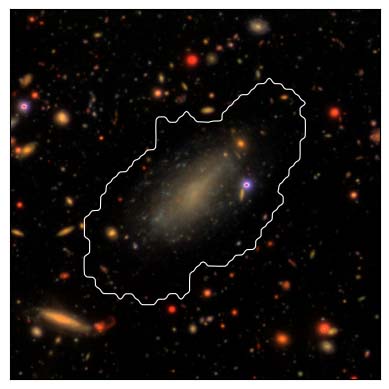A global team of astronomers have measured the fuel required for star formation in galaxies as they were 4-billion years ago.
Using the MeerKAT radio telescope, the researchers observed neutral hydrogen gas – the most abundant element in the universe and the material from which stars are formed – and found that galaxies can replenish their reservoirs of fuel for star formation.

An example of an HI-rich spiral galaxy. The image is an RGB image built using data from the Hyper Suprime-Cam at Subaru Telescope (Mauna Kea Observatory, Hawaii), and represents the light emitted from stars in the galaxy. The white contour shows the extension of the HI emission (as revealed by MeerKAT), which goes well beyond the stars and consists in a diffuse cloud of gas. The project has studied how the amount of gas changes with the number of stars and with age of the universe.
Credit: Francesco Sinigaglia/MIGHTEE
The work was led by PhD candidate Francesco Sinigaglia under the supervision of Associate Professor Giulia Rodighiero from the University of Padova, Italy; Professor Mattia Vaccari from the University of Cape Town (UCT) and the Inter-University Institute for Data Intensive Astronomy (IDIA); and Dr Ed Elson from the University of the Western Cape (UWC).
“For the first time, the team were able to measure the hydrogen gas for galaxies of different sizes and star formation activity to determine how the fuel content relates to other observable properties of galaxies 4-billion years in the past. These were compared to galaxies in the present day,” says Professor Vaccari, who is now the e-research director at UCT.
The findings surprised the astronomers who expected the amount of gas in galaxies to be larger 4-billion years ago compared to present day; and that galaxies would consume their gas in the star formation process.
Surprisingly, the gas reservoirs of such distant galaxies are similar to that observed in galaxies closer to us. This shows that galaxies can replenish their reservoirs of fuel for star formation by collecting gas from their surroundings.
The work was possible due to the sensitivity of MeerKAT, the large number of galaxies observed, and the excellent additional data at optical wavelengths.
Lead author Sinigaglia says: “We were thrilled to exploit the potential of MeerKAT to improve our understanding of the cold gas in distant galaxies. We believe this study represents a strong step forward in the field, as it delivers new pieces of information on hydrogen in galaxies, never obtained before.”
The radio data came from MIGHTEE (MeerKAT International GHz Tiered Extragalactic Exploration), an international MeerKAT large survey project.
The project involves researchers and students from five South African institutions involved in MIGHTEE. “It is exciting to be a part of such a large, international project as part of my PhD studies,” says Sambatriniaina Rajohnson, a PhD candidate at UCT.
Observations of distant galaxies was one of the prime design drivers for MeerKAT, which is built and run by the South African Radio Astronomy Observatory (SARAO). The observations from MeerKAT were processed at the ilifu cloud computing facility set up by IDIA, a partnership between UCT, UWC and the University of Pretoria.
“The data taught us a lot about the processing challenges involved and was an important testbed for coordinating science projects. Francesco’s science result is the perfect validation for our processing strategy and teamwork, providing an exciting glimpse of the future of MIGHTEE,” says Dr Bradley Frank, associate director for astronomy computing at IDIA and the co-chair of MIGHTEE-HI.
Dr Rob Adam, MD of SARAO, comments: “This is wonderful fundamental science, made possible by South Africa building the most powerful telescope of its kind in the world, thereby attracting international collaboration with South Africans at the very top level.”

